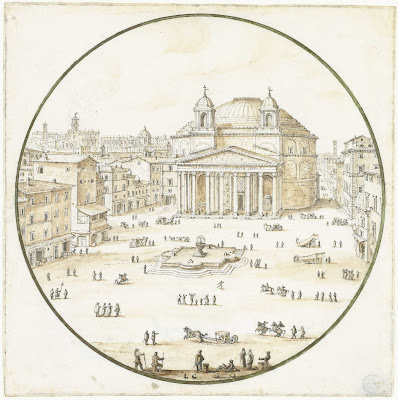 |
| Willem Schellinks Interior of Roman ruins, probably the Colosseum ca. 1627-28 drawing Royal Collection, Windsor |
– from Patrons and Painters: Art and Society in Baroque Italy by Francis Haskell (Yale University Press, 1980)
 |
| Jean Lemaire Architectural capriccio with Roman ruins before 1659 drawing British Museum |
 |
| Lievin Cruyl Study of the Pantheon, Rome ca. 1664-78 drawing Rijksmuseum, Amsterdam |
 |
| Gian Paolo Panini Capriccio with Roman ruins figures examining relief fragment ca. 1730 drawing Teylers Museum, Haarlem |
 |
| Paul Angier after Gian Paolo Panini Scene of soldiers beholding ancient ruins 1749 etching Teylers Museum, Haarlem |
 |
| Anonymous photographer St Peter's Square, Rome ca. 1850-59 salted paper print Getty Museum, Los Angeles |
 |
| Alessandro Specchi Cutaway of St Peter's, Rome 1687 engraving Teylers Museum, Haarlem |
 |
| Fratelli Alinari Interior of St Peter's, Rome ca. 1893-1903 photograph Rijksmuseum, Amsterdam |
 |
| Johann Ulrich Kraus Jubilee Year of 1700 in St Peter's, Rome ca. 1760 etching Teylers Museum, Haarlem |
 |
| Francesco Villamena after Michelangelo Capital design for Capitol building 1619 engraving Teylers Museum, Haarlem |
 |
| Francesco Villamena after Michelangelo Capital design for Capitol building 1619 engraving Teylers Museum, Haarlem |
 |
| François Marius Granet Church of Trinità dei Monti and Villa Medici, Rome ca. 1808 wash drawing Metropolitan Museum of Art, New York |
 |
| manner of Michiel Sweerts Market scene in Rome, Piazza Navona ca. 1650-80 oil on canvas Rijksmuseum, Amsterdam |
 |
| Simon Denis Study of clouds with sunset near Rome ca. 1786-1801 oil on paper Getty Museum, Los Angeles |